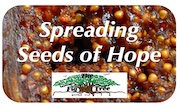Artist creates sculpture for local destination site for healing from war
 |
| Ildikó Kalapács shows model of the “Bearing” statue she plans to create and cast in bronze. |
From her childhood and early years in Szeged in southern Hungary, living under a Cold War dictatorship, Ildikó Kalapács understands suffering and cares about human rights.
She conveys those concerns both in her art—acrylic paintings and sculptures she exhibits in the Inland Northwest, Central Europe and Japan—and in her folk dancing and folk culture research.
In an upcoming exhibition, “Unwanted Journeys,” Ildikó shares images of the physical movement of refugees from their homes, their arrival in another culture and their need to adjust.
“Refugees face physical, language, cultural and psychological hurdles when they lose their home and start in a new place,” she said.
The exhibit begins with an open house from 5 to 8 p.m., Friday, March 2, at the second floor of the Object Space Gallery, 1818 1/2 E. Sprague. It is open by appointment through March.
“Unwanted Journeys” includes video, multilingual stories, poetry, drawings, sculpture, mixed media, embroidery and textiles, some by her and some from refugees.
For the exhibit, she also compiled old photos of Hungarian villages in Romania to show how they present themselves to convey their cultural and ethnic identity.
Ildikó’s other art venture is “The Bearing Public Sculpture Project,” a nonprofit organization raising funds to create, cast and install a life-size, eight-foot by nine-foot bronze statue, called “Bearing.” She created a model of the statue to promote the project.
She plans to install it in 2021 in Sunset Park at the west end of Kendall Yards beside the Centennial Trail, as a destination site for individuals and groups to visit for healing. The project also includes articles on healing from veterans and refugees.
“Bearing” celebrates the strength of women around the world, especially civilian women in war. It depicts a woman carrying, in a food basket on her head, a young man, a soldier with a gun.
While women are often the food makers and nurturers, Ildikó said that more women have died and been injured because of wars since World War I than soldiers.
“The ratio is increasing, but women are invisible in war,” Ildikó said. “We need media to cover stories of women who bear the physical and emotional load in the aftermath of wars.”
UNICEF reports that civilian fatalities have climbed from 15 percent in World War I to more than 90 percent in the 1990s with aerial bombings and door-to-door combat in villages and cities, rather than there being clear battlefields and civilian areas.
“The burden of war on society is a multi-generational trauma, especially for refugees and veterans who do not have ways to process issues,” Ildikó said. “When they arrive at their new home or return home, there is no healing place. They are ashamed to talk about what happened to them and what they have done.
“I hope people—tribes, veterans, women and others—come to the statue as a destination site, a place to deal with and heal from traumas of war and loss,” she said.
Ildikó also told how her commitment to art, folk dance, folk lore and human rights intersect.
Unable to attend an art university in Hungary, she studied from ages 14 to 18 at a special art school. Then from 1983 to 1987, she made a living as a stone carver and folk dancer.
Because she wanted to be an art historian, she moved in 1986 near Budapest, where she met her husband Wayne Kraft, a German professor at Eastern Washington University (EWU), at a folk dancing event. He was there on a one-year Fulbright scholarship to study folk dancing and the Hungarian language.
“During the Cold War, Fulbright scholarships were important ways for people to build connections,” she said.
Ildikó came to the United States in 1987 to study at EWU. She earned a bachelor’s degree in studio art in 1992.
Since graduating, she has created art works, as well as performing, choreographing and teaching folk dances, and doing folklore research.
For more than 20 years, she and Wayne, who grew up in Arizona and Alaska, have done research on folklore and folk dancing. Both are fluent in Hungarian, so they have visited Hungarian-speaking villages in post-Communist Romania for their research. They also do translation to build communication between Americans and Hungarians.
In interviewing villagers, Ildikó gathers information to share at anthropological conferences in the U.S. and forums on how non-Western societies function and how traditional culture is often tied to farming.
“When farms fail and are swallowed up in large-scale, capitalist farms, villages break up, and the people lose their culture,” she said. “Some farmers are able to keep their land and cultivate it to sustain their families.”
People were tied to the land in feudalism. Hungary was an agricultural country until 1945. The culture, economy and lifestyle of peasants was about caring for the land from birth to death, she said.
“Today, people try to continue the non-GMO, manual farming because it’s better for them and the environment,” Ildikó said. “If they can stay in the community they can sustain their language and culture.”
In Romania, the minorities are Hungarian, Roma, Germans and a small number of Jews, so staying on the land is not just about how they treat the land, but also about human rights as minorities.
“We cannot separate healthy food production and rights of access to safe drinking water,” said Ildikó, noting that the issues of sustaining land, water, language and culture apply on any continent.
Ildikó said the Hungarian Folk Dance movement going to isolated villages in Transylvania strengthened peasants living under dictatorship 40 years ago to now, helping them realize the issues they face are global issues for minorities.
“Native Americans and African Americans in the U.S. also struggle to keep their cultures,” she said. “It’s a long-term fight everywhere.”
Ildikó said it raises villagers’ self-esteem for academics to come to study their culture, assuring them that there is something valuable in their way of life.
Today, teachers, priests, pastors, doctors and judges have major roles in the villages of Central Europe, helping maintain strict cultural values but also helping children rethink options for their future, beyond farming tasks.
“They know most of the people and have authority, both positive and negative,” she said.
In her art, Ildikó captures different dynamics, metaphors and images of peasants’ lives, as well as her concern about minority rights and water rights.
“Western culture is invasive, and communities have lost much through wars. They cling to what is tangible and enduring,” she said.
When Ildikó exhibits her art in Central Europe and Japan, in particular, she hopes to start a dialogue and hear reactions of viewers there to images she creates.
Ildikó said her parents and grandparents saw war and had no way to address it. Her grandparents were peasants with limited education, and her parents were blue collar workers.
Because they experienced wars and life under a strict dictatorship, they lacked control over their lives. What they read, saw and listened to were censored. That abuse and strictness were passed on in their family.
“Growing up like that was not healthy, but it was how I became sensitive to suffering, which I convey in my art,” Ildikó said.
“I saw damage because people did not have a way to talk about the pain and trauma they experienced so they could digest it and have a healthy society,” she said.
Ildikó grew up atheist and humanist in the Communist society, so she is not religious, but believes it is important for refugees, veterans and others to forgive themselves, their families and others.
“Forgiveness is important,” she said. “For me, it’s important to forgive my family, forgive others and forgive myself. Too many people carry guilt and anger.
“My values are to care for the poor, marginalized and sick,” she added, noting that the marker for a strong democracy is in how it treats marginalized people.”
That’s why art, folk dance, folklore research and human rights come together in her life.
For information, call 747-0979, email The Bearing Project or visit www.thebearingproject.com.
Copyright © January 2018 - The Fig Tree






